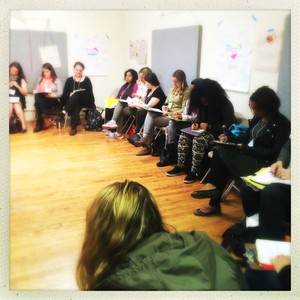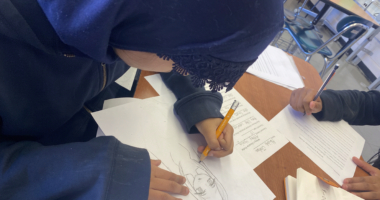I was inspired to apply to the Teaching Artist Training Internship Program (TATIP) with Community-Word Project because I felt I could make a difference in the lives of children throughout the city. I was confident I could bring something valuable and engaging to the classroom. I was so excited! Interestingly enough, upon acceptance in to the program, I started to question my enthusiasm. Why was this important to me? What if the kids don’t listen to me? Did I really have enough skills and expertise to provide to the kiddos? I was experiencing extreme self-doubt and some anxiety about the road ahead. I didn’t have an answer for any of these questions.
The first Saturday workshop was here and there was a mixture of emotions… jitterbugs, butterflies, adrenalin. It was very similar to the first day of school, ironically. The room was bright, inviting and visually appealing. Our first activity was a “graffiti wall”. In this activity, there are multiple questions sprinkled around the room on large pieces of paper. You are to move around the room, answering the questions, on the paper. This is a quiet and introspective activity. At the end, the walls resemble graffiti with an arrangement of colors and fonts imprinted from the users.

To my surprise all of the questions listed on the walls were ones that I had asked myself prior to embarking on this journey in to the classroom. I was confronted with the exact doubt that I had tried to avoid. Questions like “when did you first realize you were an artist? When did you realize that you wanted to share your craft? What is your worst fear in being in the classroom?” These were all pretty tough to answer, however, the first task, in the first hour, of the first workshop, was to do just that.

From a trainer’s perspective, it’s a brilliant way to open the class. It’s a quiet activity; however, because participants have to move around to answer the questions, it doesn’t leave time for students to get bored. It also implements multiple intelligences – an essential when teaching.
As you walk around the graffiti walls, not only do you place your answer, but you take some time to read others. This creates sameness and a common goal among a diverse group of participants with different background. You’ve also created a basis or foundation for the entire series. The intention has been formed by the students, not the teacher. We’ve now been able to identify and acknowledge why we are here. And whenever there is doubt, we can return to our original intention and navigate from there.

We learn very early on that teaching in the classroom is so not about us. It’s about the children that we see and their lives that we enhance. Program Director for Training & Internships, Patti Chilsen, mentioned “you can’t waste a minute”. You’ve got to squeeze every drop out of every lesson because our kids are depending on us for success. They are depending on us to be consistent, to be accessible, to be challenging and to aware. First, aware of their challenges and barriers that they might not be able to fully express. Next, challenge them to do better, be better and respond better, because we know they can. We recognize that they are capable of that. We must remain accessible to their learning habits as they may change and can be completely different than their neighbor. Finally, we remain committed and consistent to them for the whole school year and quite possibly for years to come. They deserve that from us.
There’s no doubt that this is difficult work, not for the faint of heart. However, you will learn very early on in the TATIP workshops why you are here. Once that’s solidified, the rest falls right in to place.

-Deanna Green, TATIP Trainee, Dancer & Yoga Instructor



